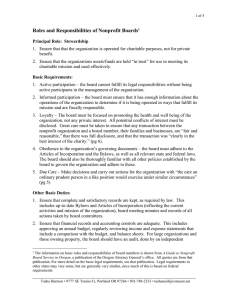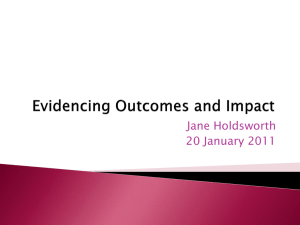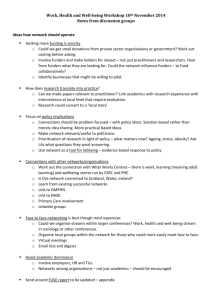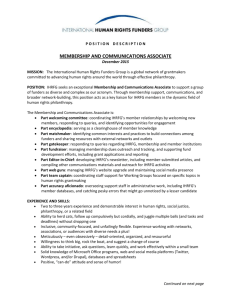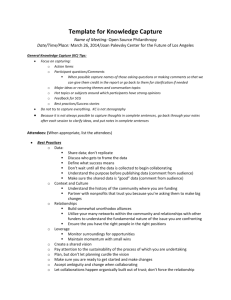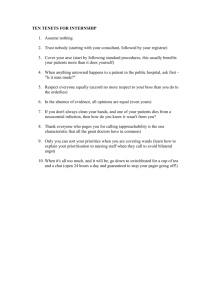basic principles for designing a strategic planning process
advertisement
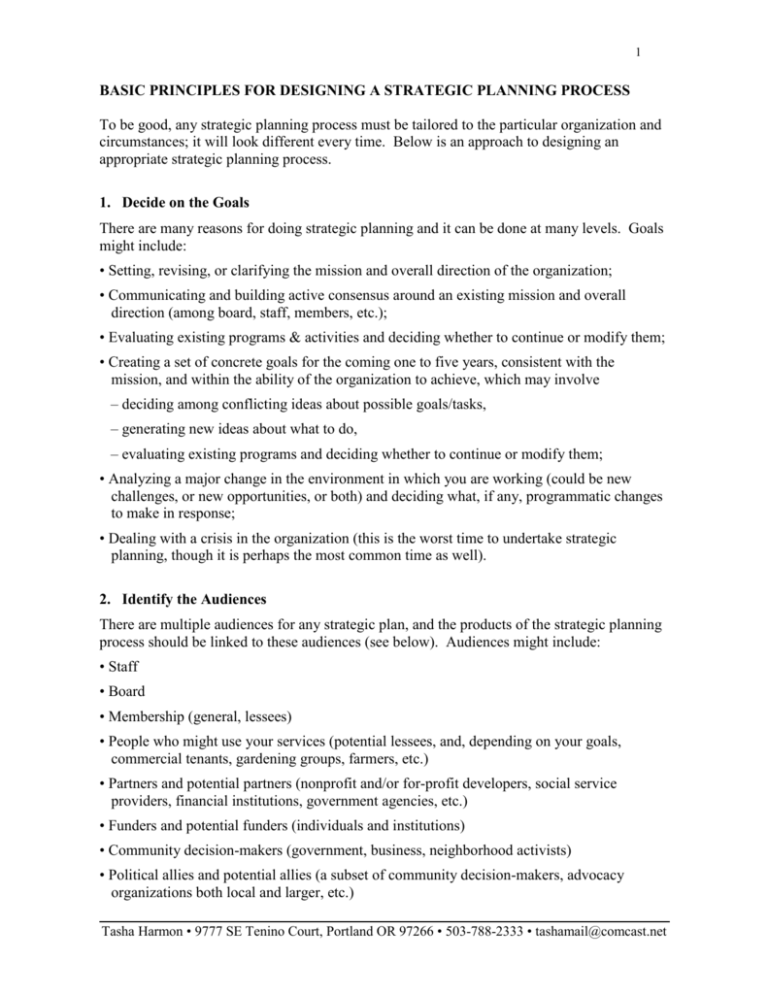
1 BASIC PRINCIPLES FOR DESIGNING A STRATEGIC PLANNING PROCESS To be good, any strategic planning process must be tailored to the particular organization and circumstances; it will look different every time. Below is an approach to designing an appropriate strategic planning process. 1. Decide on the Goals There are many reasons for doing strategic planning and it can be done at many levels. Goals might include: • Setting, revising, or clarifying the mission and overall direction of the organization; • Communicating and building active consensus around an existing mission and overall direction (among board, staff, members, etc.); • Evaluating existing programs & activities and deciding whether to continue or modify them; • Creating a set of concrete goals for the coming one to five years, consistent with the mission, and within the ability of the organization to achieve, which may involve – deciding among conflicting ideas about possible goals/tasks, – generating new ideas about what to do, – evaluating existing programs and deciding whether to continue or modify them; • Analyzing a major change in the environment in which you are working (could be new challenges, or new opportunities, or both) and deciding what, if any, programmatic changes to make in response; • Dealing with a crisis in the organization (this is the worst time to undertake strategic planning, though it is perhaps the most common time as well). 2. Identify the Audiences There are multiple audiences for any strategic plan, and the products of the strategic planning process should be linked to these audiences (see below). Audiences might include: • Staff • Board • Membership (general, lessees) • People who might use your services (potential lessees, and, depending on your goals, commercial tenants, gardening groups, farmers, etc.) • Partners and potential partners (nonprofit and/or for-profit developers, social service providers, financial institutions, government agencies, etc.) • Funders and potential funders (individuals and institutions) • Community decision-makers (government, business, neighborhood activists) • Political allies and potential allies (a subset of community decision-makers, advocacy organizations both local and larger, etc.) Tasha Harmon • 9777 SE Tenino Court, Portland OR 97266 • 503-788-2333 • tashamail@comcast.net 2 3. Identify the Products to be Delivered These will be linked to your goals and audience. In most cases, there will be more than one product. Products generated in the strategic planning process might include: • A short, nicely laid out strategic plan summary for a program or the whole organization, to be distributed to stakeholders (staff, board members, potential board members, members, funders and potential funders, community decision-makers, etc.) (See PCLT Draft) • A longer document, laying out the same outcome goals and information as the summary, but with more detail on implementation, for use by staff, board, committees, etc. • An annual work plan, linked to the strategic plan outcomes, used to manage work and track and report progress. • Outcome-based job descriptions for staff (and sometimes for the board and board committees) linked to the annual work plan and/or the strategic plan. • A fundraising plan, linked to the strategic plan outcomes 4. Identify the Stakeholders and their Needs and Abilities to Contribute Stakeholders are a subset of “Audience” (above). They are the people whose input you want when you are creating the plan because you want them invested in its success. How many of stakeholders there will be and what their roles will be will vary enormously based on your goals. Some strategic planning processes are very internal to the organization and involve little if any input beyond staff and board. Others are quite expansive, involving many interviews or focus groups with a wide variety of people outside the organization, and sometimes even including some outsiders on the planning team. Ways to Identify Stakeholders • People who have to implement the plan are stakeholders. • People who you want to actively support the plan are stakeholders. • People whose thinking you highly value, or who have information or data you need, may or may not be stakeholders. You may need something from them to do the planning well, but you may not need them to do anything to make the plan succeed, and they may not have a vested interest in you. Decide whether to treat them as stakeholders or just as sources of information based largely on whether you are trying to get them vested in you. • Some common stakeholders include: staff, board members, potential board members, members, funders and potential funders, and community decision-makers. Questions to ask about the needs of, and for, stakeholders include: • Does this group/person need to be a part of the whole process, or just provide input at a key point or several key points? • Do they need input on all of the plan, or just a portion most effecting them? • Do they need to be a visible part of the process in order to feel acknowledged? • Do you need them to be a visible part of the process to add legitimacy? Tasha Harmon • 9777 SE Tenino Court, Portland OR 97266 • 503-788-2333 • tashamail@comcast.net 3 • Do they need to be consulted about the goals and structure for the process before you set it up? Questions to consider about the ability of stakeholders to contribute to the process include: • How much time will this person/group contribute enthusiastically to this process? • Are there other things they can contribute? (data, funding, names of others to include, publicity for the effort, etc.) • What ways would be easiest for this stakeholder to be involved? (see below) Can we get what we need from them in those ways? Ways to Involve Stakeholders include: • Survey them (written, verbal, standard set of questions or open-ended conversation, depending on stakeholder and process). • Interview them (expanded “survey). • Invite them to a focus group meeting (or more than one over the course of the process). • Invite them to join a committee working on the strategic plan or some part of it. 5. Identify the Resources you have The strategic planning process you design must be consistent with the resources at your disposal (though or course you can decide what you think is ideal and then come up with the resources to accomplish it). Resources to assess include: • Money • Staff time (both total, and in any given week or month, which will help you decide how intensive the process can be) • Volunteer time and expertise (board, others; again both total, and in any given week or month, which will help you decide how intensive the process can be) • Consultants available • Length of time for the process (based on when you need the decisions and product done and what seems possible given other resources – especially staff and board time) • Decisions already made and familiar processes that can be applied to this task Do not under estimate the amount of staff and board time it takes to do good strategic planning. It will be highly frustrating for all concerned if you think this is going to take 10 hours and it takes 40, or if you propose doing something in 6 weeks that will take 10 or 20. It is also important not to let the process go on for too long – people burn out. It is important to take the planning process seriously as an organizational investment and prioritize it while you are dong it. Tasha Harmon • 9777 SE Tenino Court, Portland OR 97266 • 503-788-2333 • tashamail@comcast.net 4 When and Why to Use a Consultant for Strategic Planning What to Use Consultants To Do 1. You can hire someone to play very specific and limited roles, i.e. • Facilitate a board or staff retreat • Consult with the executive director or board chair on how the process should be designed • Do the layout of the externally-oriented Plan Summary 2. You can hire someone to work with the organization throughout the full strategic planning process, essentially as a project manager. In this case they would help you • Design the process • Carry out the work (organize the meetings, create all the materials needed to do the process with input from the executive director, board chair or a team of leaders, etc.) • Write the final products 3. Pretty much anything in between. It can be useful to create a long-term relationship with a consultant who can play various roles in your strategic planning over a number of years. Their learning curve will be shorter and faster each time and you will have a good sense of what they can provide and how well you work together. Some Times and Reasons to Hire a Consultant • When your staff and board are already stretched thin doing the work of the organization and don’t have time to organize and run another process. • When all of the players are strongly vested in particular outcomes and you need a more neutral voice to facilitate and manage the process. • When the specific skills or knowledge you want for your strategic planning process don’t exist inside your organization. • When an outside perspective would be useful. Capacity Building A good consultant will do the tasks you have assigned them in ways that will help build the capacity of your organization to continue that work. • Staff and board should be learning how to do planning by participating in the process, • You should be left with tools and structures that make it easier to do planning and to implement plans as you move forward For this to happen, your consultant must have this goal in mind, and your organization must invest sufficient staff and board time in the process. Tasha Harmon • 9777 SE Tenino Court, Portland OR 97266 • 503-788-2333 • tashamail@comcast.net
